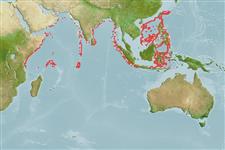Environment: milieu / climate zone / depth range / distribution range
Ecology
Marine; brackish; bathydemersal; amphidromous (Ref. 51243); depth range 800 - 875 m (Ref. 44037). Tropical; 26°N - 8°S, 33°E - 127°E
Indo-West Pacific: From the Red Sea to Java and Sulawesi (Ref. 9830) north to the Philippines, Hong Kong and Taiwan (7238).
Length at first maturity / Size / Weight / Age
Maturity: Lm 123.5, range 122 - 125 cm
Max length : 250 cm TL male/unsexed; (Ref. 7238); common length : 180 cm TL male/unsexed; (Ref. 7238)
Dorsal spines (total): 0; Anal spines: 0; Vertebrae: 132 - 135. Body robust and eel-shaped; mouth very large, with gape reaching well beyond eye; dorsal fin inserted before gill-openings, 57-68 fin-rays before level of vent; pectoral fins relatively small, about 4 times in head length; lateral line pores before level of anus 41 or 42 (Ref. 4832).
Found in coastal waters and estuaries, on soft bottom (Ref. 30573). Feeds at night, on bottom fishes and crustaceans (Ref. 30573). Marketed mainly fresh. Caught also by bag (dol) net.
Castle, P.H.J., 1984. Muraenesocidae. In W. Fischer and G. Bianchi (eds.) FAO species identification sheets for fishery purposes. Western Indian Ocean (Fishing Area 51). Volume III. FAO, Rome. (Ref. 7238)
IUCN Red List Status (Ref. 130435)
Threat to humans
Harmless
Human uses
Fisheries: commercial
Tools
Special reports
Download XML
Internet sources
Estimates based on models
Preferred temperature (Ref.
123201): 5.4 - 11.7, mean 6.8 °C (based on 18 cells).
Phylogenetic diversity index (Ref.
82804): PD
50 = 0.7500 [Uniqueness, from 0.5 = low to 2.0 = high].
Bayesian length-weight: a=0.00132 (0.00056 - 0.00309), b=2.93 (2.73 - 3.13), in cm total length, based on LWR estimates for this (Sub)family-body shape (Ref.
93245).
Trophic level (Ref.
69278): 4.3 ±0.75 se; based on food items.
Generation time: 6.9 ( na - na) years. Estimated as median ln(3)/K based on 1
growth studies.
Resilience (Ref.
120179): Medium, minimum population doubling time 1.4 - 4.4 years (Fec=310,000-920,000).
Prior r = 0.76, 95% CL = 0.50 - 1.14, Based on 1 full stock assessment.
Fishing Vulnerability (Ref.
59153): High vulnerability (64 of 100).
Nutrients (Ref.
124155): Calcium = 42 [25, 85] mg/100g; Iron = 0.815 [0.480, 1.382] mg/100g; Protein = 18.3 [16.1, 20.8] %; Omega3 = 0.212 [0.089, 0.638] g/100g; Selenium = 161 [79, 315] μg/100g; VitaminA = 10.6 [3.3, 33.2] μg/100g; Zinc = 0.646 [0.443, 0.965] mg/100g (wet weight);
